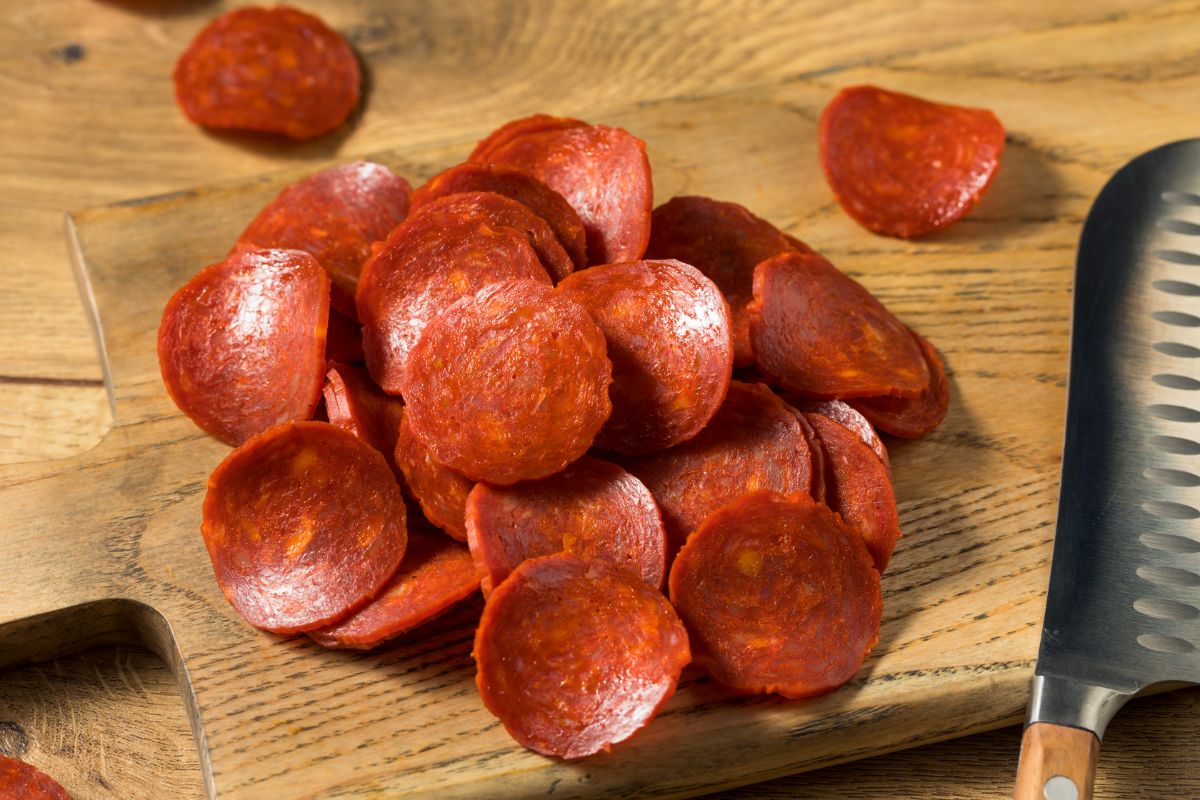Everyone knows about pepperoni! It’s absolutely delicious, and it is one of the most popular pizza toppings out there. But one important question about this ingredient remains – what is pepperoni made of?

In this article, we will be covering everything you need to know about pepperoni, including what it is made of, where it comes from, and what it can be used for!
Some of the answers we go through might surprise you, so be sure to stick around and find out some juicy information.
About Pepperoni
Pepperoni is a type of spicy salami. This food is made from a type of meat, and a host of other ingredients, which we will cover in a moment.
There are a number of uses for this delicious ingredient, and only one of them is on pizzas!
While you might think that pepperoni is Italian (it certainly sounds Italian, right?), this food is actually American!
Well, it was technically created by Italian immigrants, but its birthplace is the mighty New York in the early 1900s.
Ever since its conception, pepperoni has become a favorite globally, and is a staple when it comes to pizza toppings.
We feel it is worth mentioning that there is another kind of “pepperoni” – but this is spelled peperone, and this is simply the Italian word for peppers or capsicums.
In Italy, the pepperoni we are all familiar with is called spiced salami, and it is only occasionally served in a handful of Italian restaurants!
What Is Pepperoni Made Of?
So, from the name that Italians use, we already know that pepperoni is essentially just spiced salami. As such, two ingredients are clear: some kind of meat, and seasoning!
However, what are the exact ingredients used to make pepperoni?
This is what we will explore below, so maybe you can even prepare your own pepperoni at home if you have the correct ingredients and equipment!
The Ingredients
The basic ingredients needed to make pepperoni are as follows:
- Pork
- Salt
- Water
- Spices
- Lactic Acid (Starter Culture)
- Sodium Nitrate
- Other Flavorings
- Acids (To Preserve)
As you can see from this list, there isn’t a lot of information to go on, because recipes vary greatly from place to place. Even the meat, or meat combination, that is used to make pepperoni can vary.
Some places like to mix pork and beef together to make this delicious food, while others prefer to only use pork.
Recently, other varieties such as chicken pepperoni have also been created to help cater for different needs and preferences. However, the traditional pork is still the favorite and is the most flavorful.
Ingredients like salt, water, lactic acid, sodium nitrate, and other acids to help with preservation are the standard(see also: What Is Tonic Water?).
Other flavorings and spices can vary depending on the recipe that is being used, and also the region the pepperoni is being made.
Types Of Pepperoni
There are actually around 13 different types of pepperoni that you might come across! As we have mentioned, the traditional pork pepperoni is the most common (and popular).
However, there are other options, which we will go through below
Pepperoni Based On Preparation
- Cubed pepperoni – cubed or diced pepperoni is very versatile and readily available at many grocery stores
- Cup char pepperoni – looks a lot like flat laid pepperoni, but the slices are curved into the shape of a cup, so the edges crisp up when cooked
- Stick pepperoni – comes in long sticks and is very versatile, from snacking sticks to being chopped up for use in other recipes
- Flat laid pepperoni – thinly sliced pepperoni that is commonly used as a pizza topping, but can be used for various other dishes and snacks
Ingredient-Based Pepperoni Types
- Gluten-free pepperoni – pepperoni that contains no gluten and poses no risk of cross-contamination, which is a serious issue with most pepperoni
- Plant-based pepperoni – pepperoni made from plant-based ingredients to make it suitable for vegans and vegetarians(see also: Do Vegetarians Eat Eggs?)
- Low sodium pepperoni – this pepperoni typically contains about 50% less sodium than regular pepperoni, but it still has a lot!
Meat-Based Pepperoni Types
- Pork pepperoni – classic pepperoni made from pork
- Beef pepperoni – pepperoni options made from beef instead of pork
- Venison pepperoni – pepperoni made from venison, which comes from game animals such as deer
- Poultry pepperoni – this can come from turkeys or chickens, or other poultry animals
Pepperoni Types Based On Culture
- Kosher pepperoni – pepperoni that has been prepared in a Kosher way to be suitable for the strict dietary standards in the traditional Jewish law
- Halal pepperoni – pepperoni that has been prepared in a halal way to be suitable for the strict dietary standards in the traditional Islamic law
What Is Pepperoni Used For?
While we might all instinctively think of pepperoni pizza when we are working with this ingredient, there are plenty of other things you can use pepperoni for!

Take a look at some of these delicious options that you might want to consider instead of a pizza:
- Pepperoni chips
- Pepperoni bread
- Pepperoni casserole
- Pepperoni pizza rolls
- Pepperoni penne
- Pepperoni omelet
- Pepperoni monkey bread
- Pepperoni Muffins
There are plenty of other delightful recipes to try out, but these are a good place to start. Any recipe with pepperoni is guaranteed to be delicious, but always remember how much sodium is in this ingredient!
Final Thoughts
Pepperoni is a delicious variety of spicy salami created by Italian immigrants in New York back in the early 1900s.
This delightful ingredient is incredibly versatile, and can be used for so much more than just pizza toppings!
You can use pork, beef, venison, and poultry to make pepperoni, and seasonings can change depending on where the product is made. You could even try making your own pepperoni if you feel up for it – just know that it takes time.
Overall, pepperoni (in all its various forms) is not going anywhere. This delicious food is here to stay, and the dozen or so varieties of it make it easily accessible for everyone and anyone.
Get out there and get some pepperoni!
- How To Fill a King Cake With Bavarian Cream - April 15, 2024
- Dealing With Mold on Oyster Mushrooms - April 9, 2024
- What Meat Goes With Pumpkin Ravioli? (Ravishing Ravioli Combos) - March 15, 2024
